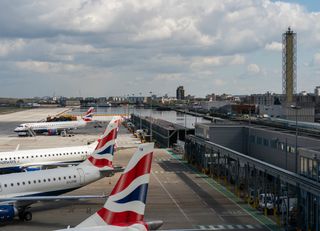London City becomes first major airport to start controlling air traffic remotely
The new tower is 115km away from the airport and will use a host of digital data to provide an “enhanced reality” view

London City Airport claims to be the first major international airport in the world to be fully controlled by a remote digital air traffic control tower, which is based 115km away at NATS’ air traffic control centre in Swanwick, Hampshire.
The multi-million-pound investment will see a dedicated team of controllers use live footage from the airport, captured through 16 high-definition cameras and sensors mounted on a mast, an audio feed, and radar information to communicate with aircraft.
The live feed, which is transmitted through an independent secure fibre network, is displayed on 14 HD screens in the Swanwick control room to provide a panoramic moving image. This can be overlaid with digital data which the airport claims will provide an “enhanced reality” view.
The data includes information such as call signs, altitude and speed of all aircraft, weather readings, and the ability to track moving objects. Pan-tilt-zoom cameras can also magnify images up to 30 times for close inspection.
“Digital tower technology tears up a blueprint that’s remained largely unchanged for 100 years, allowing us to safely manage aircraft from almost anywhere, while providing our controllers with valuable new tools that would be impossible in a traditional control tower,” said Juliet Kennedy, NATS operations director.
The airport said the new technology significantly improves controllers’ situational awareness, enabling quick and informed decisions to improve safety and operational efficiency. The technology was pioneered by Saab Digital Air Traffic Solutions, which has successfully tried and tested the system at Örnsköldsvik and Sundsvall airports in Sweden.
The digital control tower was completed in 2019 and has been through a period of testing before becoming fully operational. The 30-year old analogue tower, which would have otherwise required a significant upgrade, is set to be redeveloped as part of the airport’s modernisation programme.
Get the ITPro. daily newsletter
Receive our latest news, industry updates, featured resources and more. Sign up today to receive our FREE report on AI cyber crime & security - newly updated for 2024.
In 2019, Heathrow began trialling AI technology to see whether the proposed third runway could be built without the need for a new control tower. It built a £2.5 million “digital tower laboratory”, with a range of ultra-high definition cameras and AI technology, at the base of one of its existing towers. It was hoped that the new tech would help human controllers land more planes in difficult conditions where visibility is reduced.
Zach Marzouk is a former ITPro, CloudPro, and ChannelPro staff writer, covering topics like security, privacy, worker rights, and startups, primarily in the Asia Pacific and the US regions. Zach joined ITPro in 2017 where he was introduced to the world of B2B technology as a junior staff writer, before he returned to Argentina in 2018, working in communications and as a copywriter. In 2021, he made his way back to ITPro as a staff writer during the pandemic, before joining the world of freelance in 2022.





